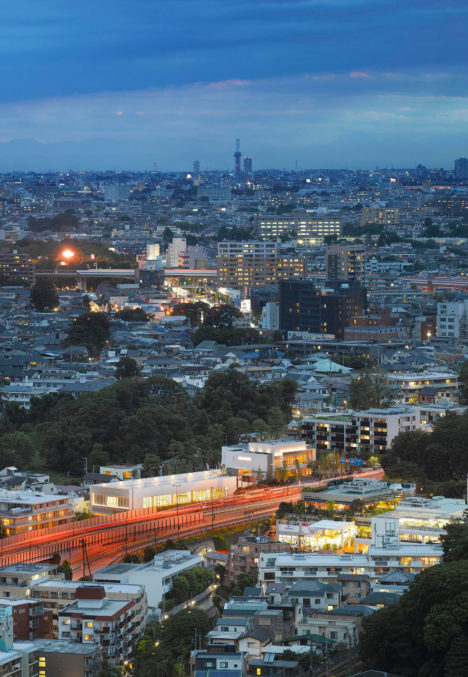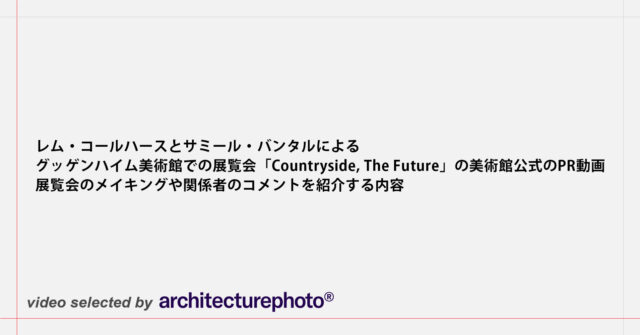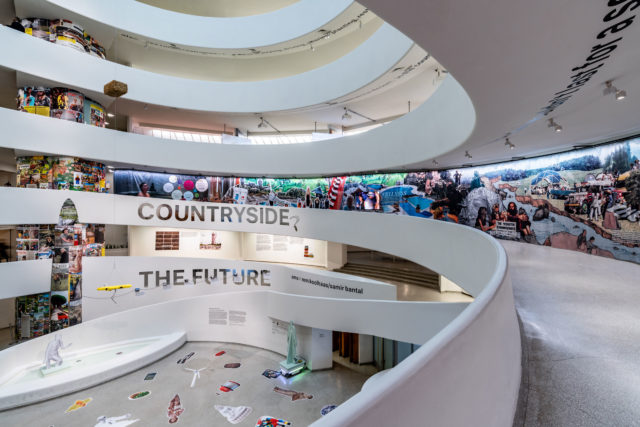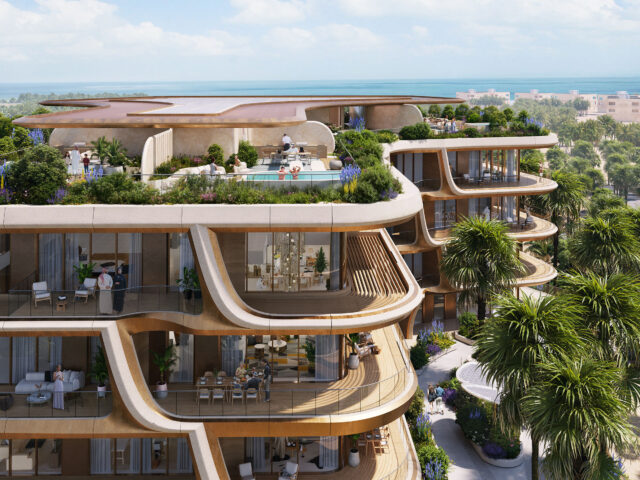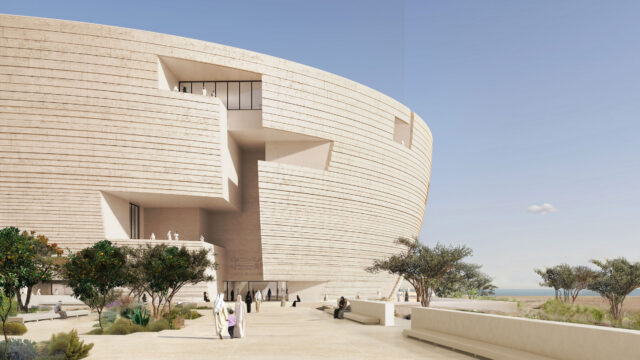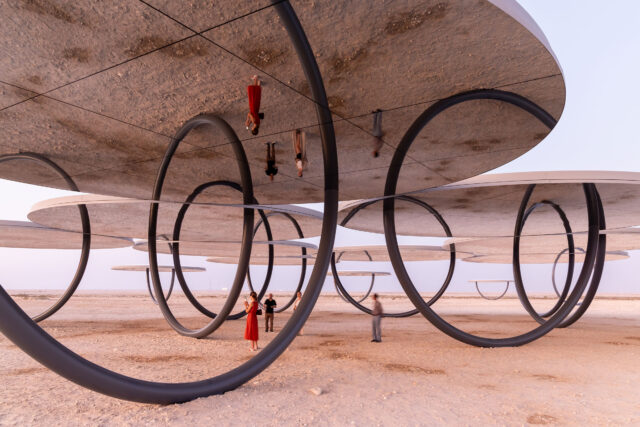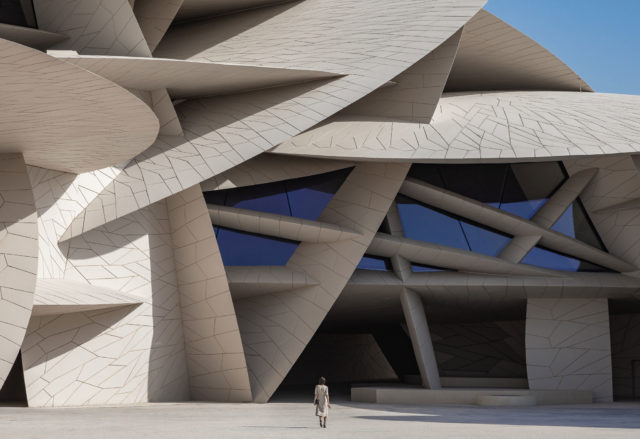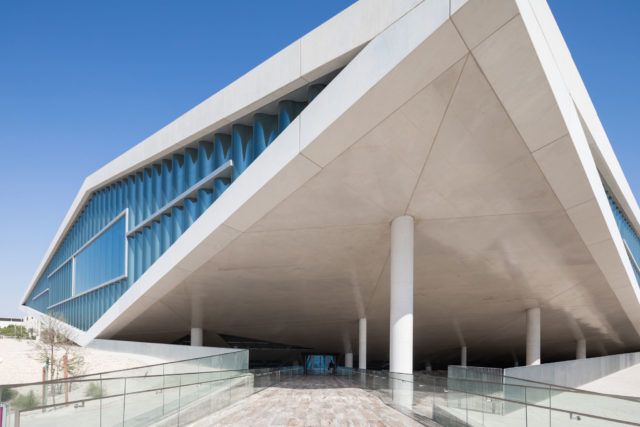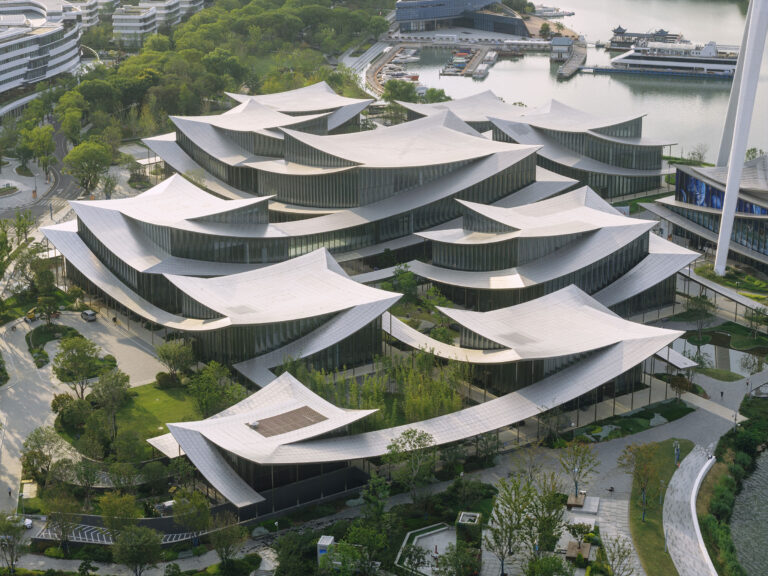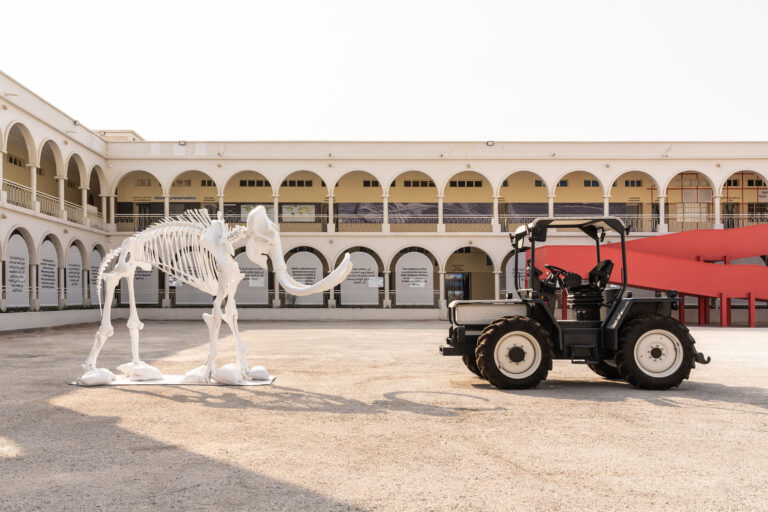
SHARE AMO / OMAによる、カタールでの展覧会「カントリーサイド:住む場所、去る場所ではない」。2020年のNYでの展示の新たな展開として企画。アフリカからアジアに広がる山岳地形の“アーク”に焦点を当て、都市生活の代替案となるプロトタイプを探索。展示に加えてワークショップ・講義・実験なども行う
- 日程
- 2025年10月28日(火)–2026年4月29日(水)




AMO / OMAによる、カタールでの展覧会「カントリーサイド:住む場所、去る場所ではない(Countryside: A Place to Live, Not to Leave)」です。
2020年のNYでの展示の新たな展開として企画されました。建築家は、アフリカからアジアに広がる山岳地形の“アーク”に焦点を当て、都市生活の代替案となるプロトタイプを探索しました。また、展示に加えてワークショップ・講義・実験なども行います。会期は、2026年4月29日まで。展覧会の公式ページはこちら。アーキテクチャーフォトでは、2020年の「カントリーサイド」展も特集記事として紹介しています。
こちらはリリーステキストです(翻訳:アーキテクチャーフォト / 原文は末尾に掲載)
AMO / OMAによる新しい展覧会「カントリーサイド:住む場所、去る場所ではない(Countryside: A Place to Live, Not to Leave)」が、カタール準備学校とカタール国立博物館で開幕しました。この展覧会は、カタール博物館がカタール開発基金(QFFD)、環境・気候変動省(MoECC)、ハッサド・フード、カラマーとの協力のもとで主催しています。
2020年にニューヨークのグッゲンハイム美術館のために制作された「カントリーサイド、ザ・フューチャー」を基盤としたこの新たなヴァージョンは、「ザ・アーク」に焦点を当てています。これは、世界人口の大半を合わせて有する地域を結びつけている広大な領域であり、南アフリカから東アフリカを経て、カタールおよび中央アジアを通り、東部中国にまで広がっています。主に山岳地形によって形づくられているこのアークは、長らく大規模な都市化に抗い、古くからの伝統が存続することを可能にしてきました。今日、この地域は急速な近代化の過程にあり、技術革新、デジタル・コネクティビティ、そして農業およびエネルギーにおける新たなアプローチによって推進されています。これらの変化は、より持続可能な方法で地球に居住するための手本となる新たなプロトタイプを生み出しており、カントリーサイドを都市生活に代わる、信頼性のある進化し続ける代替案として位置づけています。
この展覧会は、カタール準備学校とカタール国立博物館の二つの会場で構成されています。博物館では、インスタレーションが展覧会の主要なリサーチテーマを紹介し、学校で展開されるコンテンツや活動の予告を提示しています。学校での展示は、能動的な教育環境として機能しており、教室をリサーチ、議論、そして制作のための空間へと変化させています。それは、継続的に発展し続けるプロセスとして機能しており、学生、教師、そして招かれた参加者を巻き込んだワークショップ、講義、共同実験を通じて構成されています。屋外では、学校の敷地が砂漠地での栽培および持続可能な食料生産の実験場として使用されており、灌漑、水耕栽培、温室設計における新たな技術が適用され、観察されています。展覧会の期間を通じて、現地で制作された資料は、生きたドキュメントとしてまとめられ、プロジェクトの終了時に発表されるマニフェストとして結実します。
「カントリーサイド:住む場所、去る場所ではない」は、2026年6月30日まで一般公開されています。
このプロジェクトは、サミール・バンタルとレム・コールハースがリードし、ヨタム・ベン・フルが参加しました。
こちらはキュレトリアルステートメントです(翻訳:アーキテクチャーフォト / 原文は末尾に掲載)
アーク
サミル・バンタル、レム・コールハース
2020年にニューヨークのグッゲンハイム美術館で発表された「カントリーサイド」の最初のバージョンでは、私たちは、田舎が急激な変化と深刻な激変を経ていた場所を世界中からいくつか選びました。これらのズームを組み合わせることで、都市の外で展開していた危機と可能性のグローバルな概観が提示されましたが、そのために大部分が見過ごされていました。
カントリーサイドの今回の第2バージョンでは、「ジ・アーク」を紹介します。これは、南アフリカから東アフリカを通り、カタール、中央アジアを経て、中国東部にまで至る、一続きの「田舎(カントリーサイド)」の帯です。それは、内陸の田舎地域の弧(アーク)であり、いずれもいまだに主に伝統的な暮らし方が営まれている場所です。ここには、アフリカと中央アジアの両方が含まれます。そして、その中で急速な近代化が進んでいるのは中東だけです。
現在、アフリカ、中東、中央アジアには、世界の人口の85パーセントが暮らしています。2100年までには、これらの地域が依然として人類の80パーセント以上を占めることになるでしょう。その頃には、アフリカはアジアを上回り、世界で最も人口の多い大陸になっているでしょう。カタールとその周辺地域は、この人口動態の変化における地理的かつ経済的な交差点に位置しています。
私たちがこのアークをたどったのは、そこに伝統的な暮らし方と現代的な暮らし方の両方が含まれているからです。一連の危機というより、それは可能性の弧を表しています。その中で、どれほどの変化が起こりうるのか、そしてどの伝統を維持すべきかを考えることができるのです。アークの大部分は山岳地帯であり、その風景自体が全面的な近代化に抵抗しています。しかし、その息をのむような美しさは、増大する圧力にさらされています。
スマートフォンはアークに計り知れない影響を与えており、最も孤立した文化同士をつなぎ、田舎から都市へ移動する必要性そのものに疑問を投げかけています。手のひらサイズのインターネットは、情報、ファッション、ニュース、政治といった無限の流れをもたらし、まったく新しい経済を可能にしています。
アフリカにおけるアークの広い範囲は1960年代まで植民地支配を受けており、中央アジアでは1990年代初頭まで続いていました。植民地支配は、アパルトヘイトという破壊的な遺産を残したほか、アジアにおいては、大規模な農業関連の技術的・核的実験をもたらしました。これらは現在、見直され、修復が試みられています。多くの場合、これらの実験は部分的に続いています。では、ポストコロニアル(植民地後)の状況において、遺産とは何なのでしょうか?
アークには新たな類型が数多く見られます。たとえば、納屋で開かれるコーディングスクールでは、羊飼いのような古代からの伝統を維持しながら、将来のデジタル言語を身につけた次世代の田舎の担い手を育てようとしています。これらの類型は、新たな関連性をもたらすとともに、持続可能な方法で地球に住まうための新しいプロトタイプを提示しています。
都市がますます混雑し、物価も高騰する中で、転機が訪れているのかもしれません。田舎から人々を奪ってきた都市への普遍的な流れを逆転させるような未来を、私たちは想像できるのです。この展覧会は、田舎に住まうための「新たな」方法を調べています。それらは総じて、豊かで充実した人生を追求するためのモデルが都市だけではないことを示しています。
以下の写真はクリックで拡大します


















こちらはリリーステキストの原文です
Countryside: A Place to Live, Not to Leave, a new exhibition by AMO / OMA, has opened at the Qatar Preparatory School and the National Museum of Qatar, presented by Qatar Museums in collaboration with Qatar Fund for Development (QFFD), Ministry of Environment and Climate Change (MoECC), Hassad Food, and Kahramaa.
Building on Countryside, The Future, produced for the Guggenheim Museum in New York in 2020, this new iteration focuses on “the Arc” – a vast territory connecting regions that together hold most of the world’s population, stretching from South Africa through East Africa, via Qatar and Central Asia to Eastern China. Defined by predominantly mountainous topography, the Arc has long resisted large-scale urbanization, allowing ancient traditions to persist. Today, the area is undergoing rapid modernization, driven by technological innovation, digital connectivity, and new approaches to agriculture and energy. These shifts are generating new prototypes that serve as examples for inhabiting the earth in more sustainable ways, positioning the countryside as a credible, evolving alternative to life in the city.
The exhibition is organized across two sites: the Qatar Preparatory School and the National Museum of Qatar. At the museum, an installation introduces the main research themes of the exhibition and offers a preview of the content and activities developed at the school. The presentation at the school functions as an active educational environment, transforming classrooms into spaces for research, discussion, and production. It operates as a process in constant development, structured through workshops, lectures, and collective experiments that involve students, teachers, and invited contributors. Outside, the school grounds are used as a test field for desert cultivation and sustainable food production, where new technologies in irrigation, hydroponics, and greenhouse design are applied and observed. Throughout the duration of the exhibition, the material produced on site is assembled into a living document that will culminate in a manifesto published at the end of the project.
Countryside: A Place to Live, Not to Leave is open to the public until 30 June 2026.
The project was led by Samir Bantal and Rem Koolhaas with Yotam Ben Hur.
こちらはキュレトリアルステートメントの原文です
The Arc
by Samir Bantal and Rem Koolhaas
“In the first version of Countryside, presented at the Guggenheim New York in 2020, we picked a number of sites all over the world where the countryside was going through drastic changes and acute upheavals. Together, these zooms presented a global overview of crisis and potential that was unfolding outside our cities and therefore went largely unnoticed.
In this second iteration of Countryside, we present “the Arc,” a contiguous band of “Countryside” that runs from South Africa through East Africa, via Qatar, Central Asia, all the way to Eastern China. It is an arc of landlocked rural areas, still inhabited largely in traditional ways, both in Africa and Central Asia, and where only the Middle East is undergoing rapid modernization.
Today, Africa, the Middle East, and Central Asia are home to 85 percent of the world’s population. By 2100, these regions will still account for more than 80 percent of humanity. By then, Africa will have become the most populous continent, surpassing Asia. Qatar and its neighboring region sit at the geographic and eco-nomic crossroads of this demographic transformation.
We traced this arc because it encompasses both traditional and modern forms of living. Rather than a chain of crises, it represents an arc of potential, in which we can consider how much might change and what traditions should be maintained. Most of the Arc is mountainous; the landscape itself resists a wholesale modernization, though its breathtaking beauty faces mounting pressure.
The smartphone has had a colossal impact on the Arc, connecting the most isolated cultures, questioning the need to leave the countryside for the city. The handheld internet introduces limitless flows of information, fashion, news, and politics, enabling entirely new economies.
Large parts of the Arc in Africa were colonized until the 1960s, and in Central Asia until the early 1990s. Colonization has left disruptive legacies of apartheid, and in Asia, large scale agriculture-related technological and nuclear experiments that are currently being rethought and remediated. In many cases these ex-periments partly continue. What is heritage then in post-colonial conditions?
The Arc is replete with new typologies, such as coding schools in barns aiming to train the next generation of ruralists in the digital languages of the future, while maintaining ancient traditions like shepherding. These typologies introduce new relevancies and offers new prototypes for inhabiting the earth in sustainable ways.
As cities become more and more congested and expensive, maybe a pivotal moment has come: we can conceive a future that reverses the universal movement to the city that has robbed the countryside of its inhabitants. This exhibition examines “new” ways to inhabit the countryside, which together show that the city is not the only model for pursuing a rich and fulfilling life.”
■建築概要
Countryside: A Place to Live, Not to Leave
Client: Qatar Museums
Location: Qatar Preparatory School and Qatar National Museum, Doha
Year: 2025
Status: Completed
Program: Exhibition, Research
Director: Samir Bantal, Rem Koolhaas
Project Architect: Yotam Ben Hur
Team: Stephanie Achkar, Zivar Aliyeva, Sebastian Bernardy, Jorge Cerdo Schumann, Thomas Hellier, Sean Li, Vicente Mateus, Konstantinos Papasimakis, Rita Varjabedian, Owen Wang, Louisa Weeren, Aleksandr Zinovev, Marina Zuquim, Daria Zvereva

